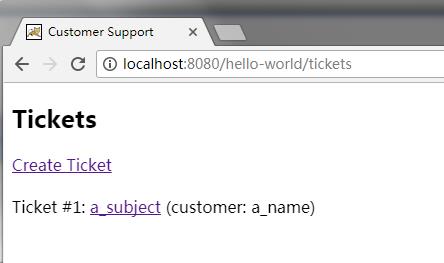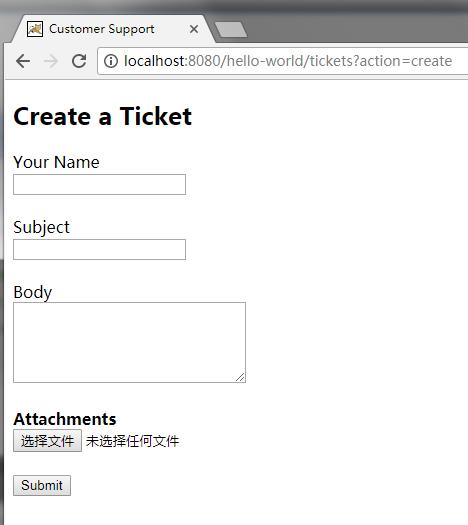JavaWeb——JSP开发2
Posted xxbbtt
tags:
篇首语:本文由小常识网(cha138.com)小编为大家整理,主要介绍了JavaWeb——JSP开发2相关的知识,希望对你有一定的参考价值。
使用JSP+Servlet实现文件的上传和下载功能
1、文件模型
首先是文件本身,这里创建一个类记录文件的名字和内容:
public class Attachment { private String name; private byte[] contents; public Attachment() { } public String getName() { return this.name; } public void setName(String name) { this.name = name; } public byte[] getContents() { return this.contents; } public void setContents(byte[] contents) { this.contents = contents; } }
其次在创建一个类记录上传者的信息,信息有用户名、主题、文件描述、已经上传的文件
public class Ticket { private String customerName; private String subject; private String body; private Map<String, Attachment> attachments = new LinkedHashMap(); public Ticket() { } public String getCustomerName() { return this.customerName; } public void setCustomerName(String customerName) { this.customerName = customerName; } public String getSubject() { return this.subject; } public void setSubject(String subject) { this.subject = subject; } public String getBody() { return this.body; } public void setBody(String body) { this.body = body; } public Attachment getAttachment(String name) { return (Attachment)this.attachments.get(name); } public Collection<Attachment> getAttachments() { return this.attachments.values(); } public void addAttachment(Attachment attachment) { this.attachments.put(attachment.getName(), attachment); } public int getNumberOfAttachments() { return this.attachments.size(); } }
2、页面逻辑
这个demo将会实现三个页面
- 默认首页,提供跳转去上传页面的链接,以及已经上传的文件列表,文件列表中文件的主题名将链接到文件的详细信息页面

- 上传文件页面,这里客户可以填写文件的详细信息,并选择文件上传,点击Submit提交之后将会进入文件的详细信息页面,表示文件成功上传

- 文件详细信息页面会展示文件的详细信息,并提供文件下载链接,和返回第一个页面的链接

3、代码逻辑
- 使用一个LinkedHashMap保存已经上传的文件信息,使用一个volatile类型的变量记录文件的id。
- 使用action进行页面的重定向,以及上传、下载功能。
public class TicketServlet extends HttpServlet { private volatile int TICKET_ID_SEQUENCE = 1; private Map<Integer, Ticket> ticketDatabase = new LinkedHashMap<>(); @Override protected void doGet(HttpServletRequest request, HttpServletResponse response) throws ServletException, IOException { String action = request.getParameter("action"); if(action == null) { action = "list"; } System.out.println(action); switch(action) { case "create": //进入上传文件页面 this.showTicketForm(request, response); break; case "view": //进入文件详细信息页面 this.viewTicket(request, response); break; case "download": //实现下载功能 this.downloadAttachment(request, response); break; case "list": default: //进入默认页面 this.listTickets(request, response); break; } } @Override protected void doPost(HttpServletRequest request, HttpServletResponse response) throws ServletException, IOException { String action = request.getParameter("action"); if(action == null) { action = "list"; } switch(action) { case "create": //实现上传功能 this.createTicket(request, response); break; case "list": default: //进入默认页面 response.sendRedirect("tickets"); break; } }
4、三个页面的JSP
- 默认界面,将接收来自请求的ticketDatabase这个map,然后通过判断这个map的大小展示已上传文件列表,还有就是还提供了两个链接修改action的值实现重定向
<%@ page session="false" import="java.util.Map" %> <% @SuppressWarnings("unchecked") Map<Integer, Ticket> ticketDatabase = (Map<Integer, Ticket>)request.getAttribute("ticketDatabase"); %> <!DOCTYPE html> <html> <head> <title>Customer Support</title> </head> <body> <h2>Tickets</h2> <a href="<c:url value="/tickets"> <c:param name="action" value="create" /> </c:url>">Create Ticket</a><br /><br /> <% if(ticketDatabase.size() == 0) { %><i>There are no tickets in the system.</i><% } else { for(int id : ticketDatabase.keySet()) { String idString = Integer.toString(id); Ticket ticket = ticketDatabase.get(id); %>Ticket #<%= idString %>: <a href="<c:url value="/tickets"> <c:param name="action" value="view" /> <c:param name="ticketId" value="<%= idString %>" /> </c:url>"><%= ticket.getSubject() %></a> (customer: <%= ticket.getCustomerName() %>)<br /><% } } %> </body> </html>
- 文件上传页面,提供用户填写信息的输入框,提供点击Submit按钮进行跳转和上传文件,将action的值赋值为create
<%@ page session="false" %>
<!DOCTYPE html>
<html>
<head>
<title>Customer Support</title>
</head>
<body>
<h2>Create a Ticket</h2>
<form method="POST" action="tickets" enctype="multipart/form-data">
<input type="hidden" name="action" value="create"/>
Your Name<br/>
<input type="text" name="customerName"><br/><br/>
Subject<br/>
<input type="text" name="subject"><br/><br/>
Body<br/>
<textarea name="body" rows="5" cols="30"></textarea><br/><br/>
<b>Attachments</b><br/>
<input type="file" name="file1"/><br/><br/>
<input type="submit" value="Submit"/>
</form>
</body>
</html>
- 文件详细信息页面,打印文件的详细信息,提供下载链接(这个链接将action值修改为download),返回默认页面的链接
<%@ page session="false" %> <% String ticketId = (String)request.getAttribute("ticketId"); Ticket ticket = (Ticket)request.getAttribute("ticket"); %> <!DOCTYPE html> <html> <head> <title>Customer Support</title> </head> <body> <h2>Ticket #<%= ticketId %>: <%= ticket.getSubject() %></h2> <i>Customer Name - <%= ticket.getCustomerName() %></i><br /><br /> <%= ticket.getBody() %><br /><br /> <% if(ticket.getNumberOfAttachments() > 0) { %>Attachments: <% int i = 0; for(Attachment a : ticket.getAttachments()) { if(i++ > 0) out.print(", "); %><a href="<c:url value="/tickets"> <c:param name="action" value="download" /> <c:param name="ticketId" value="<%= ticketId %>" /> <c:param name="attachment" value="<%= a.getName() %>" /> </c:url>"><%= a.getName() %></a><% } %><br /><br /><% } %> <a href="<c:url value="/tickets" />">Return to list tickets</a> </body> </html>
5、具体方法的实现
- listTickets方法将会把这个map传递给一会将要运行的JSP,然后通过方法getRequestDispatcher可以获得一个javax.servlet.RequestDispatcher,这个对象将用于处理针对指定路径的内部转发和包含,通过该对象,将请求转发给调用forward方法的listTickets.jsp
private void listTickets(HttpServletRequest request, HttpServletResponse response) throws ServletException, IOException { request.setAttribute("ticketDatabase", this.ticketDatabase); request.getRequestDispatcher("/WEB-INF/jsp/view/listTickets.jsp") .forward(request, response); }
- showTicketForm方法将同样调用getRequestDispatcher,将请求转发给ticketForm.jsp
private void showTicketForm(HttpServletRequest request, HttpServletResponse response) throws ServletException, IOException { request.getRequestDispatcher("/WEB-INF/jsp/view/ticketForm.jsp") .forward(request, response); }
- createTicket方法将在上传页面点击Submit之后调用,通过request.getParameter获取请求的参数,创建一个Ticket对象并设置其CustomerName、Subject、Body,之后使用request.getParts()获取上传的文件,获取一个Part对象filePart,调用processAttachment()方法将这个Part对象转化为Attachment对象,然后添加到Ticket对象中,再然后将TICKET_ID_SEQUENCE加一作为id放入Map中,然后重定向到文件的详细信息页面
private void createTicket(HttpServletRequest request, HttpServletResponse response) throws ServletException, IOException { Ticket ticket = new Ticket(); ticket.setCustomerName(request.getParameter("customerName")); ticket.setSubject(request.getParameter("subject")); ticket.setBody(request.getParameter("body")); Part filePart = request.getPart("file1"); if(filePart != null && filePart.getSize() > 0) { Attachment attachment = this.processAttachment(filePart); if(attachment != null) { ticket.addAttachment(attachment); } } int id; synchronized(this) { id = this.TICKET_ID_SEQUENCE++; this.ticketDatabase.put(id, ticket); } response.sendRedirect("tickets?action=view&ticketId=" + id); }
这里的processAttachment方法实现了将这个Part对象转化为Attachment对象,具体是先从Part获得InputStream,并将其复制到Attachment对象中。然后还使用了getSubmittedFileName()获取文件名。
private Attachment processAttachment(Part filePart) throws IOException { InputStream inputStream = filePart.getInputStream(); ByteArrayOutputStream outputStream = new ByteArrayOutputStream(); int read; final byte[] bytes = new byte[1024]; while((read = inputStream.read(bytes)) != -1) { outputStream.write(bytes, 0, read); } Attachment attachment = new Attachment(); attachment.setName(filePart.getSubmittedFileName()); attachment.setContents(outputStream.toByteArray()); return attachment; }
- viewTicket方法首先是获取id,然后根据这个id调用getTicket方法获取到Ticket对象。获取到Ticket对象之后把这个对象和id一起以及请求转发给viewTicket.jsp
private void viewTicket(HttpServletRequest request, HttpServletResponse response) throws ServletException, IOException { String idString = request.getParameter("ticketId"); Ticket ticket = this.getTicket(idString, response); if(ticket == null) { return; } request.setAttribute("ticketId", idString); request.setAttribute("ticket", ticket); request.getRequestDispatcher("/WEB-INF/jsp/view/viewTicket.jsp") .forward(request, response); }
其次这个根据id获取Ticket的getTicket方法如果有什么错误将会被重定向到/tickets页面
private Ticket getTicket(String idString, HttpServletResponse response) throws ServletException, IOException { if(idString == null || idString.length() == 0) { response.sendRedirect("tickets"); return null; } try { Ticket ticket = this.ticketDatabase.get(Integer.parseInt(idString)); if(ticket == null) { response.sendRedirect("tickets"); return null; } return ticket; } catch(Exception e) { response.sendRedirect("tickets"); return null; } }
- downloadAttachment方法这个方法首先是根据id获取Ticket对象,然后从请求中获取文件的名字,根据这个name从Ticket中获取文件的Attachment对象。
private void downloadAttachment(HttpServletRequest request, HttpServletResponse response) throws ServletException, IOException { String idString = request.getParameter("ticketId"); Ticket ticket = this.getTicket(idString, response); if(ticket == null) { return; } String name = request.getParameter("attachment"); if(name == null) { response.sendRedirect("tickets?action=view&ticketId=" + idString); return; } Attachment attachment = ticket.getAttachment(name); if(attachment == null) { response.sendRedirect("tickets?action=view&ticketId=" + idString); return; } response.setHeader("Content-Disposition", "attachment; filename=" + attachment.getName()); response.setContentType("application/octet-stream"); ServletOutputStream stream = response.getOutputStream(); stream.write(attachment.getContents()); }
最后的这几行代码,用于处理浏览器的下载请求,响应中设置头Content-Disposition,将强制浏览器询问客户是保存还是下载文件,而不是在浏览器从查看文件,设置的文件类型是通用的/二进制内容类型的,这样容器就不会使用字符编码对该数据进行处理。最后使用ServletOutputStream将文件内容输出到响应中。如果希望实现大文件下载,应该将数据从文件的InputStream中复制到ResponseOutputStream ,并且经常刷新ResponseOutputStream,这样数据才能不断被发送到用户浏览器中。
以上是关于JavaWeb——JSP开发2的主要内容,如果未能解决你的问题,请参考以下文章